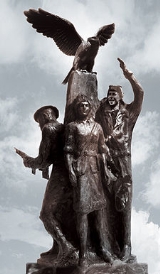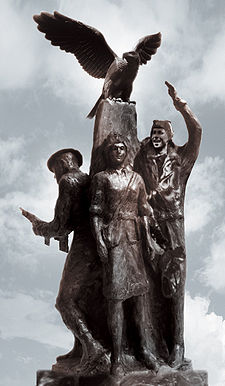
Polish Forces War Memorial:National Memorial Arboretum
Encyclopedia

National Memorial Arboretum
The National Memorial Arboretum is a national site of remembrance at Alrewas, near Lichfield, Staffordshire, England. It gives its purpose as:-Origins:...
near Lichfield
Lichfield
Lichfield is a cathedral city, civil parish and district in Staffordshire, England. One of eight civil parishes with city status in England, Lichfield is situated roughly north of Birmingham...
, Staffordshire
Staffordshire
Staffordshire is a landlocked county in the West Midlands region of England. For Eurostat purposes, the county is a NUTS 3 region and is one of four counties or unitary districts that comprise the "Shropshire and Staffordshire" NUTS 2 region. Part of the National Forest lies within its borders...
, England
England
England is a country that is part of the United Kingdom. It shares land borders with Scotland to the north and Wales to the west; the Irish Sea is to the north west, the Celtic Sea to the south west, with the North Sea to the east and the English Channel to the south separating it from continental...
, comprises 150 acres of woodland and memorials dedicated to the fallen servicemen and women from World War I
World War I
World War I , which was predominantly called the World War or the Great War from its occurrence until 1939, and the First World War or World War I thereafter, was a major war centred in Europe that began on 28 July 1914 and lasted until 11 November 1918...
, World War
World war
A world war is a war affecting the majority of the world's most powerful and populous nations. World wars span multiple countries on multiple continents, with battles fought in multiple theaters....
and other conflicts of the 20th Century. Until now there has been no memorial dedicated to the Poles who lost their lives during World War II despite the fact that Polish Forces served with the Allies
Allies of World War II
The Allies of World War II were the countries that opposed the Axis powers during the Second World War . Former Axis states contributing to the Allied victory are not considered Allied states...
from the first day of war until the last — fielding the fourth largest Allied army in the fight against Nazi German tyranny across Europe
Europe
Europe is, by convention, one of the world's seven continents. Comprising the westernmost peninsula of Eurasia, Europe is generally 'divided' from Asia to its east by the watershed divides of the Ural and Caucasus Mountains, the Ural River, the Caspian and Black Seas, and the waterways connecting...
. Poles gave their lives on all fronts - on land, at sea and in the air
Polish contribution to World War II
The European theater of World War II opened with the German invasion of Poland on September 1, 1939. The Polish Army was defeated after over a month of fighting. After Poland had been overrun, a government-in-exile , armed forces, and an intelligence service were established outside of Poland....
, where they distinguished themselves with courage and self-sacrifice.
Four humble toy soldiers, each painted a bronze
Bronze
Bronze is a metal alloy consisting primarily of copper, usually with tin as the main additive. It is hard and brittle, and it was particularly significant in antiquity, so much so that the Bronze Age was named after the metal...
colour and glued back-to-back atop a two-pence piece
Two pence (British decimal coin)
The British decimal two pence coin – often pronounced "two pee" – was issued by the Royal Mint on 15 February 1971, the day the British currency was decimalised. In practice it had been available from banks in bags of £1 for some weeks previously...
, created by Dr. Andrzej Meeson-Kielanowski, provided the inspiration behind the monument’s design. It was decided that the statue design would be based on the model soldier concept and would comprise four sculptures of typical members of the different branches of the Polish Armed Forces: the Air Force, the Army, the Navy and the Polish Underground Home Army
Armia Krajowa
The Armia Krajowa , or Home Army, was the dominant Polish resistance movement in World War II German-occupied Poland. It was formed in February 1942 from the Związek Walki Zbrojnej . Over the next two years, it absorbed most other Polish underground forces...
. The Airman is a Polish pilot from RAF 303 Squadron
No. 303 Polish Fighter Squadron
No. 303 Polish Fighter Squadron was one of 16 Polish squadrons in the Royal Air Force during the Second World War. It was the highest scoring RAF squadron of the Battle of Britain....
during the Battle of Britain
Battle of Britain
The Battle of Britain is the name given to the World War II air campaign waged by the German Air Force against the United Kingdom during the summer and autumn of 1940...
; the Underground figure is a woman courier wearing civilian clothes; the Army is represented by a typical Polish soldier from the battle of Monte-Cassino
Battle of Monte Cassino
The Battle of Monte Cassino was a costly series of four battles during World War II, fought by the Allies against Germans and Italians with the intention of breaking through the Winter Line and seizing Rome.In the beginning of 1944, the western half of the Winter Line was being anchored by Germans...
; the Sailor is a crew member of the Polish destroyer
Destroyer
In naval terminology, a destroyer is a fast and maneuverable yet long-endurance warship intended to escort larger vessels in a fleet, convoy or battle group and defend them against smaller, powerful, short-range attackers. Destroyers, originally called torpedo-boat destroyers in 1892, evolved from...
Błyskawica. In addition, the figures are ‘combined’ with an eagle uniting all four sculptures under its outspread wings.
The Polish Forces War Memorial statue is set within an imposing 18 metre diameter architectural feature and has a series of plaques inset into the monument surround describing the Polish contribution in the Second World War so therefore the monument will act not only as a tribute to the fallen, but also as an educational aid for those visitors not familiar with the history of the allied Polish Forces during World War II.
The instigators of the Polish Forces Memorial project, Dr. Marek Stella-Sawicki, who is the project committee’s chairman, and Dr. Andrzej Meeson-Kielanowski, deputy chairman, were the driving force behind the Memorial with the aim to commission the design and construction of an imposing bronze monument of fitting artistic and architectural merit. Renowned Polish figurative sculptor Robert Sobociński was commissioned to create design mock-ups for the War Memorial statues with the plan that the final bronze statue was to be cast in Poznań
History of Poznan
Poznań, today Poland's fifth largest city, is also one of the country's oldest cities, and was an important political and religious center in the early Polish state of the 10th century...
, Poland
Poland
Poland , officially the Republic of Poland , is a country in Central Europe bordered by Germany to the west; the Czech Republic and Slovakia to the south; Ukraine, Belarus and Lithuania to the east; and the Baltic Sea and Kaliningrad Oblast, a Russian exclave, to the north...
and shipped to Great Britain
Great Britain
Great Britain or Britain is an island situated to the northwest of Continental Europe. It is the ninth largest island in the world, and the largest European island, as well as the largest of the British Isles...
ready for installation at the National Memorial Arboretum in the early summer of 2009. The installation of the monument was followed by an unveiling ceremony during September 2009, to coincide with the 70th anniversary of the outbreak of the Second World War.
The Polish Forces Memorial project main sponsors and associated organisations:
- The Polish Ex-Combatants Association (Polish:Polish languagePolish is a language of the Lechitic subgroup of West Slavic languages, used throughout Poland and by Polish minorities in other countries...
Stowarzyszenie Polskich Kombatantów) - The Association of Polish Knights of The Sovereign and Military Order of Malta (UK)
- The Polish Air Force Association Charitable Trust (Polish:Polish languagePolish is a language of the Lechitic subgroup of West Slavic languages, used throughout Poland and by Polish minorities in other countries...
Stowarzyszenie Lotników Polskich) - The Polish Underground Movement (1939-1945) Study Trust (Polish:Polish languagePolish is a language of the Lechitic subgroup of West Slavic languages, used throughout Poland and by Polish minorities in other countries...
Studium Polski Podziemnej)
External links
- The Polish Forces War Memorial official site
- The National Memorial Arboretum official site
- The Association of Polish Knights of The Sovereign and Military Order of Malta (UK)
- The Association of Polish Knights of Malta (UK) official site
- Sculptor Robert Sobociński official site
- The Polish Underground Movement (1939-1945) Study Trust official site

